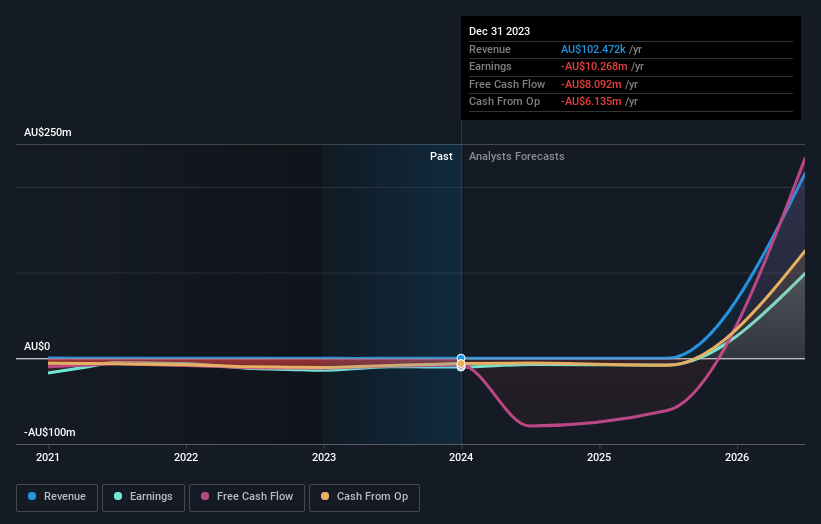- Australia
- /
- Oil and Gas
- /
- ASX:LOT
Lotus Resources Limited's (ASX:LOT) market cap dropped AU$110m last week; individual investors who hold 45% were hit as were institutions

Key Insights
- The considerable ownership by individual investors in Lotus Resources indicates that they collectively have a greater say in management and business strategy
- A total of 13 investors have a majority stake in the company with 50% ownership
- Insiders have sold recently
Every investor in Lotus Resources Limited (ASX:LOT) should be aware of the most powerful shareholder groups. And the group that holds the biggest piece of the pie are individual investors with 45% ownership. In other words, the group stands to gain the most (or lose the most) from their investment into the company.
While institutions who own 33% came under pressure after market cap dropped to AU$742m last week,individual investors took the most losses.
Let's delve deeper into each type of owner of Lotus Resources, beginning with the chart below.
See our latest analysis for Lotus Resources

What Does The Institutional Ownership Tell Us About Lotus Resources?
Institutions typically measure themselves against a benchmark when reporting to their own investors, so they often become more enthusiastic about a stock once it's included in a major index. We would expect most companies to have some institutions on the register, especially if they are growing.
Lotus Resources already has institutions on the share registry. Indeed, they own a respectable stake in the company. This suggests some credibility amongst professional investors. But we can't rely on that fact alone since institutions make bad investments sometimes, just like everyone does. If multiple institutions change their view on a stock at the same time, you could see the share price drop fast. It's therefore worth looking at Lotus Resources' earnings history below. Of course, the future is what really matters.

Lotus Resources is not owned by hedge funds. Grant Burnaford Davey is currently the largest shareholder, with 8.2% of shares outstanding. In comparison, the second and third largest shareholders hold about 7.3% and 7.2% of the stock. Furthermore, CEO Keith Bowes is the owner of 0.6% of the company's shares.
A closer look at our ownership figures suggests that the top 13 shareholders have a combined ownership of 50% implying that no single shareholder has a majority.
While studying institutional ownership for a company can add value to your research, it is also a good practice to research analyst recommendations to get a deeper understand of a stock's expected performance. There is some analyst coverage of the stock, but it could still become more well known, with time.
Insider Ownership Of Lotus Resources
The definition of company insiders can be subjective and does vary between jurisdictions. Our data reflects individual insiders, capturing board members at the very least. Company management run the business, but the CEO will answer to the board, even if he or she is a member of it.
I generally consider insider ownership to be a good thing. However, on some occasions it makes it more difficult for other shareholders to hold the board accountable for decisions.
It seems insiders own a significant proportion of Lotus Resources Limited. Insiders have a AU$91m stake in this AU$742m business. This may suggest that the founders still own a lot of shares. You can click here to see if they have been buying or selling.
General Public Ownership
The general public, who are usually individual investors, hold a 45% stake in Lotus Resources. While this size of ownership may not be enough to sway a policy decision in their favour, they can still make a collective impact on company policies.
Private Company Ownership
Our data indicates that Private Companies hold 10%, of the company's shares. It's hard to draw any conclusions from this fact alone, so its worth looking into who owns those private companies. Sometimes insiders or other related parties have an interest in shares in a public company through a separate private company.
Next Steps:
It's always worth thinking about the different groups who own shares in a company. But to understand Lotus Resources better, we need to consider many other factors. Take risks for example - Lotus Resources has 3 warning signs (and 1 which is significant) we think you should know about.
Ultimately the future is most important. You can access this free report on analyst forecasts for the company.
NB: Figures in this article are calculated using data from the last twelve months, which refer to the 12-month period ending on the last date of the month the financial statement is dated. This may not be consistent with full year annual report figures.
New: AI Stock Screener & Alerts
Our new AI Stock Screener scans the market every day to uncover opportunities.
• Dividend Powerhouses (3%+ Yield)
• Undervalued Small Caps with Insider Buying
• High growth Tech and AI Companies
Or build your own from over 50 metrics.
Have feedback on this article? Concerned about the content? Get in touch with us directly. Alternatively, email editorial-team (at) simplywallst.com.
This article by Simply Wall St is general in nature. We provide commentary based on historical data and analyst forecasts only using an unbiased methodology and our articles are not intended to be financial advice. It does not constitute a recommendation to buy or sell any stock, and does not take account of your objectives, or your financial situation. We aim to bring you long-term focused analysis driven by fundamental data. Note that our analysis may not factor in the latest price-sensitive company announcements or qualitative material. Simply Wall St has no position in any stocks mentioned.
About ASX:LOT
Lotus Resources
Engages in the exploration, evaluation, and development of uranium properties in Africa.
Excellent balance sheet with reasonable growth potential.


